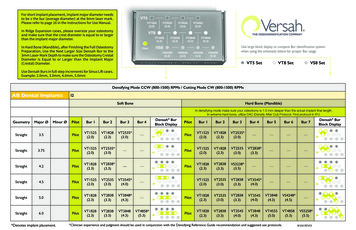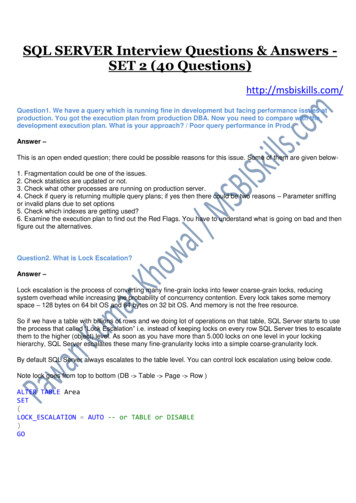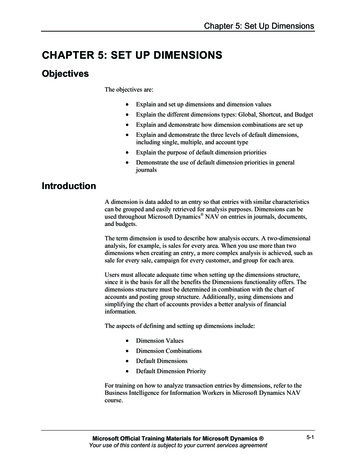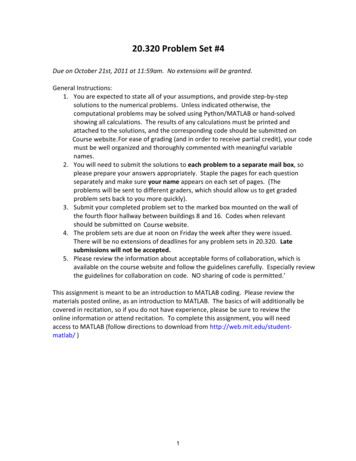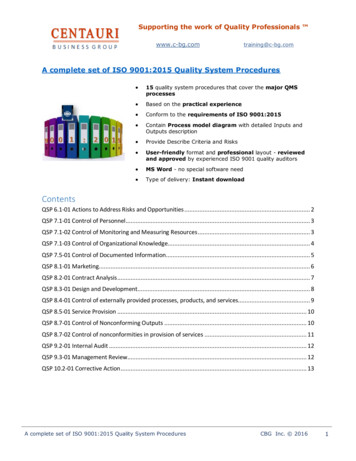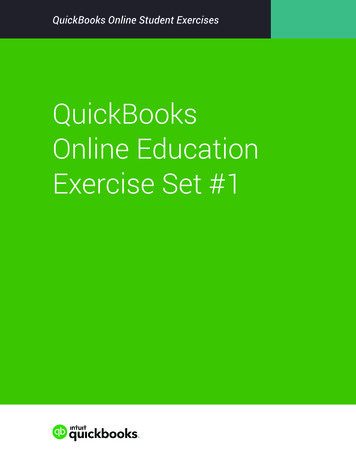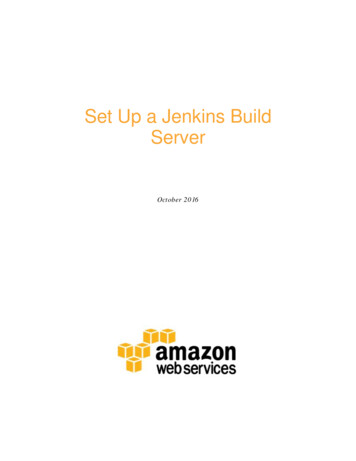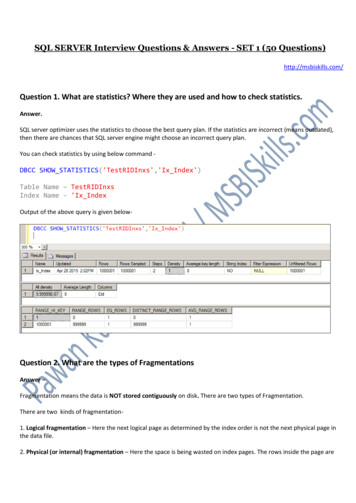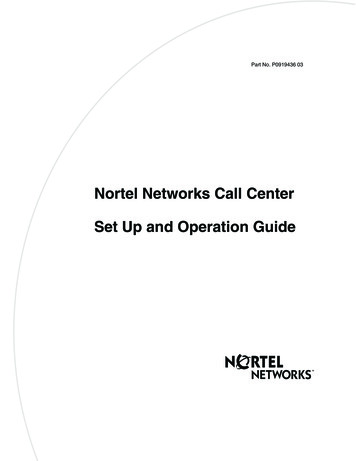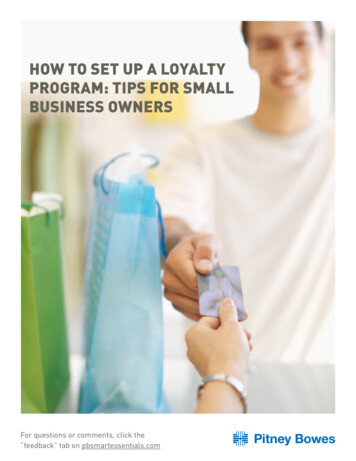
Transcription
How to Set Up a LoyaltyProgram: Tips for SmallBusiness OwnersFor questions or comments, click the“feedback” tab on pbsmartessentials.com
How do I keep my customers coming back?It is a question that concerns every businessowner, and it is especially important when youare a smaller business. Loyalty programscan be a hugely effective tool for customerretention, and big businesses spend millionsof dollars a year building customer loyalty.The good news is loyalty programs are notoff limits to small business owners. It ismore than possible to establish dynamic andinteractive customer loyalty programs on abudget. We created this resource to give yousome ideas about basic program types, aswell as some tips and thought-starters forcreating your own.What’s in it for your business?A loyalty program helps you build relationships with your customers and gives you anedge over the competition. This makes loyaltyprograms particularly valuable in categorieswhere it is difficult to gain a competitiveadvantage through product features or pricealone.A well-managed program can also give youinsights into your customer’s behavior andpreferences, making it easier for you to givethem what they want. Regular programnewsletters, emails, mailings and socialmedia updates enable you to keep the linesof communication open between you andyour clients, and encourage feedback andsuggestions.2How to Set Up a Loyalty Program:Tips for Small Business Owners
How do I keep my customers coming back?Subtitlejakldf jal;sdfjl;a jsdfl;ajdfls; jal;dfj al;sdj fla;js fla;sdjfal;d fja;lfdasdfasdf asdfasdf adfs asdf“Different types of loyalty programsBecause loyalty programs come in a variety ofdifferent types, small businesses can set upaffordable, easy-to-manage programs to suittheir particular category and clientele. Hereare a few examples: Buy 10 get one free – The traditionalpunch-card is popular with independentbusinesses like coffee shops, greetingcard stores and beauty salons. Points for purchase – Customers earnpoints based on how much they spend,which can be applied as credit againstfuture purchases. Partner rewards – Create partnershipswith businesses in your area that yourcustomers may have an interest in. Awinery that offers vineyard tours mightoffer discounts coupons for a local bedand breakfast, for example.3How to Set Up a Loyalty Program:Tips for Small Business OwnersThat can helpto keep themcoming back,and it can alsoencourage goodword-of-mouthadvertising.”By giving regular customers a little extra,whether it’s a free coffee, a discount couponor a gift card, you are showing them that youvalue their business – making them feel likethey’re getting a bit of personal attention.That can help to keep them coming back, andit can also encourage good word-of-mouthadvertising.
Setting up your own programWhen deciding what kind of program is rightfor your business, think about what most ofyour customers buy and how often they buyit from you. If you sell raw materials in bulktwice a year to most customers, a frequentbuyer program probably doesn’t make sense.But, you want to reward their loyalty soconsider offering a discount on the productif they buy a certain amount. You might alsosend a thank you gift, unrelated to your product, such as a gift card for popular retailers.If you own a bakery, restaurant or coffeeshop and serve the same customers severaltimes a week, a frequent buyer card is ideal.Since every consumer is different, you shouldprovide various ways for people to participatein your loyalty program. Some people mightprefer to build up points and redeem themonline. Others prefer a physical card youcheck off or punch.4How to Set Up a Loyalty Program:Tips for Small Business OwnersHere are some factors to consider when planning your own loyalty program:1. Think about the customersyou’re targeting.As with any marketing program, you’llneed to determine who the target audience is for your loyalty program. Youwant to know what their interests andpreferences are so that the rewardsyou’re offering will be of interest andvalue to them. Their purchasing behavioris equally important; how often they buyfrom you and how much they spend maydetermine whether your program rewardsare based on frequency of visits or totalspend. You can gather this informationthrough a variety of means, from studying their purchase history to conductingonline or informal in-person surveys.
How do I keep my customers coming back?Understanding your customers better willalso help ensure that you’re targeting thevarious segments of your customer baseappropriately. The key factors that determine the value of your repeat customersare “recency,” frequency and monetary.Recency refers to how recent their mostvisit was. Frequency refers to how oftenthey visit, and monetary is how much theyspend with you. Analyzing these factorswill help to give you a complete pictureof your most valuable customers.2. Look at the numbers.Your loyalty program will have costs associated with it: advertising and marketingcosts, the value of your incentives, the costof setting up a point-of-sale card system ifapplicable, and of course the value of yourown time. Create a marketing plan with aprojection of the cost of the program in dollars and cents, and then define what kind ofreturn you’ll need from your customers inorder to make the program viable. Like anymarketing plan, this is something you’llwant to come back to and re-examine regularly once the program is up and running.While you’re doing your calculations,keep in mind that in addition to encouraging more frequent visits and increasedspending, your loyalty program can helpencourage upgrades to more profitableproducts. This is particularly true of points5How to Set Up a Loyalty Program:Tips for Small Business Ownersprograms, which give you the opportunityto influence the purchase of slower-movingor higher-margin items with bonus points.3. Make the most of available resources.There’s no reason you have to start fromscratch when creating a loyalty program.As mentioned above, there may be a potential for valuable reward partnerships withinyour business network or local businessassociation. Your colleagues within yourindustry may also be able to provide youwith insights into customer behavior andpreferences, and what sorts of incentives have worked for them in the past.Digital technology is also invaluableas a low or even no-cost resource tosupplement your program. Social mediaplatforms like Facebook and Twitter arefree channels to promote your program,and they can also be used to listen to whatyour customers are saying about you totheir peers. Location-based services thatoffer check-ins can be great indicatorsof loyalty and some, notably Foursquare,allow merchants to promote specials offersto customers through their services.
“Keeping the relationship freshKeeping your program fresh and interesting will help stave off boredom and attritionamong your customers. One of the mostimportant aspects of your program will becommunication. Regular updates will let yourcustomers know that the program is activeand evolving. And any responses you elicitfrom them will help you fine tune the program so that it’s relevant to their needs.You can promote and monitor the health ofyour program through: Newsletters – Regular emailnewsletters allow you to stay in touch andpromote program offers. Surveys – Informal polls and surveyson your website, your Facebook page, orin-store can help you gauge customersatisfaction and preferences for futurepromotions. Transactions and redemption –Measurement is an important part ofany marketing effort. How members aremaking use of the program, and how theirpurchase behavior compares to that ofnon-members, will be the true gauge ofyour success.Stay in touch with program members to makesure the program is providing them with thekind of value they’re looking for. Take advantage of all the channels at your disposal – if6How to Set Up a Loyalty Program:Tips for Small Business OwnersOne of themost importantaspects of yourprogram will becommunication.”you don’t have a Facebook page and Twitteraccount for your business yet, your newloyalty program is another good reason toget started. All relationships thrive on communication, and customer relationships areno exception.What Next?Read more about customer loyalty atpbsmartessentials.com.Discover how Pitney Bowes can help you stayin touch with your most valuable customerswith our Small Business Marketing Solutions.Ready to start communicating with yourcustomers and building loyalty? Sign upfor your 60-day free trial of Pitney Bowes’email marketing tool and start creatingyour own email newsletters, eventannouncements and promotions.
For questions or comments, click the“feedback” tab on pbsmartessentials.com
punch-card is popular with independent businesses like coffee shops, greeting card stores and beauty salons. Points for purchase – Customers earn points based on how much they spend, which can be applied as credit against future purchases. Partner rewards – Create partnerships with businesses in your area that your customers may have an interest in. A winery that offers vineyard .
